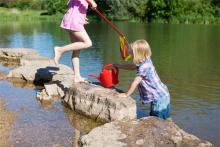
What is Free Play?
Free play is unstructured, voluntary, child-initiated activity that allows children to develop their imaginations while exploring and experiencing the world around them.1 It is the spontaneous play that comes naturally from children’s natural curiosity, love of discovery, and enthusiasm.2
Playing with dolls, blocks, molding clay, crayons and paper, and other loose parts all allow for unstructured creative play.3Outdoor play encourages space for all kinds of physical activity, such as building forts, playing on playgrounds, and climbing trees.
Play theorist, Bob Hughes, has identified sixteen play types. Some of these play types are role-play, dramatic, fantasy, exploratory, creative, social, rough and tumble, locomotor, and symbolic. These all relate to physical, social, cognitive, creative, and emotional development through free play.4
The American Academy of Pediatrics’ Clinical Report on The Importance of Play in Promoting Healthy Child Development and Maintaining Strong Parent-Child Bonds lists many benefits of free play for children. They include: healthy cognitive development, use of creativity and expansion of imagination, interaction with the world around them, development of social skills in learning to share and resolve conflicts, practice in decision-making skills, and confidence building.5
Jean Piaget wrote extensively in his book, Play, Dreams and Imitation in Childhood, about the links between play and intellectual, cognitive development. He outlined a progression of free play activities, such as functional, exploratory, sensorimotor activities (holding a rattle, repeatedly dropping a toy as play) to more symbolic play as the child ages to include building with blocks and pretending to feed a doll. The final developmental stage is when the child can play games with rules, such as tag or marbles.6
Free play encourages children to develop their imagination while using their creativity. Playing with toys that can only be used one way and passive activities like playing video games do not employ creativity.7
Pretending and role-playing are important activities for children to expand their understanding of the world around them and prepares them for the adult world. Children gain confidence as they learn how to solve their own problems and develop other social skills like sharing, listening to other’s ideas, give and take, and compromising.8
Free play develops motor skills as children run, jump, and chase outdoors and play on a well-equipped playground. Swinging freely on overhead playground equipment develops upper body strength as well as agility, balance, eye-hand coordination, and fitness. Free play in outdoor activities engages more motor behaviors than in structured physical education classes.9
The American Academy of Pediatrics’ Clinical Report stated that the need for unstructured free play in the life of children “is so important to optimal child development that it has been recognized by the United Nations High Commission for Human Rights as a right of every child.”10 The report suggests several societal changes that impact the routine of childhood and reduce the opportunity for free play:
- Families are smaller with parents busy with work schedules and little free time to care for children.
- There is an increasing pressure felt by parents to make time productive for children filling it with academic activities and enrichment programs.
- The No Child Left Behind Act has inadvertently pressured schools to drop creative play activities, such as recess, the arts, and physical education, which will likely impact the emotional and social development of children.
- The passive entertainment of television and computer/video games decreases the amount of free play activity which also impacts the mental, social, and physical development of the children as well as their future health.
- Finally, the report acknowledged that in many communities it is unsafe for children to play outside of the home without close adult supervision and protection.11
- 1. “Why your child needs ‘free play’” Rediff.com. < http://in.rediff.com/getahead/2007/may/17child.htm > 16 Aug. 2010.
- 2. “Free Play” Hasbro.com. < http://www.hasbro.com/playdoh/en_US/freePlay.cfm > 16 Aug. 2010.
- 3. Peters, Diane. “Creative Kids: 5 Ways to Spark Their Imaginations. Free Play.” Kaboose.com. < http://parenting.kaboose.com/age-and-stage/creative_freeplay.html > 16 Aug. 2010.
- 4. Cole, Sally and Chris Taylor. “Free Play for All Ages.” Children Webmag.com. < http://www.childrenwebmag.com/articles/play-articles/free-play-for-all-ages > 16 Aug. 2010.
- 5. Ginsburg, Kenneth R. “The Importance of Play in Promoting Healthy Child Development and Maintaining Strong Parent-Child Bonds. American Academy of Pediatrics. < http://www.aap.org/pressroom/playFINAL.pdf > 16 Aug. 2010.
- 6. Frost, Joe L., Sue Wortham, and Stuart Reifel. Play and Child Development. Upper Saddle Valley, NJ: Prentice-Hall, 2001. pp. 46-47.
- 7. “The Benefits of Free Play.” Raise Smart Kid.com. < http://www.raisesmartkid.com/articles/the-benefits-of-free-play.html > 16 Aug. 2010.
- 8. Op. cit., “Why your child needs ‘free play.’”
- 9. Op. cit., Frost. p. 166.
- 10. Op. cit., Ginsburg.
- 11. Newbauer, Connie. “Free-play and Childhood. Societal Changes and Childhood Impact.” Suite101.com. < http://earlychildhood.suite101.com/article.cfm/free_play_and_childhood > 16 Aug. 2010.

